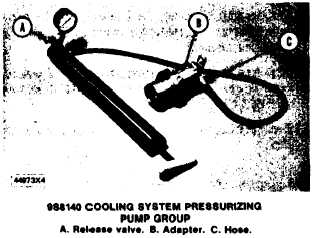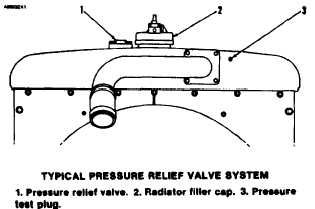COOLING SYSTEM
TM 5-3805-263-14&P-2
TESTING AND ADJUSTING
Filler Cap and Pressure Relief Valve
The 9S8140 Cooling System Pressurizing Pump
Group is used to test pressure relief valves and to
pressure check the cooling system for leaks.
8.
One cause for a pressure loss in the cooling system
can be a bad seal on the radiator filler cap (2).
9.
10.
2.
3.
4.
5.
6.
7.
Install and tighten the filler cap.
Remove hose (C) from adapter (B).
Remove the pressure test plug (3) from the ra-
diator top tank.
Install the end of hose (C) in the hole for the
pressure test plug (3).
Operate the pump until the pointer on the
pressure gauge no longer increases. The highest
pressure indication on the gauge is the point
that the relief valve opens. The correct pres-
sure that makes the relief valve open is 14 to 18
psi (95 to 125 kPa).
If the relief valve does not open within pressure
specification, replacement of the relief valve is
necessary.
If the relief valve is within specifications, check
the radiator for outside leakage.
Check all connections and hoses for the cooling
system for outside leakage.
If you do not see any outside leakage and the
pressure reading on the gauge is still the same
after 5 minutes, the radiator and cooling system
does not have leakage. If the reading on the
gauge goes down and you do not see any outside
leakage, there is leakage on the inside of the
cooling system. Make repairs as necessary.
If a pressure indication is shown on the gauge,
be sure to push release valve (A) to release all
pressure in the system before removal of hose
(C) from radiator.
If the engine has been running and the coolant
is hot, loosen the filler cap slowly and let the
pressure out of the cooling system, then re-
move the filler cap.
11. Remove hose (C) from radiator test pressure
location.
12. Install plug in pressure test location.
Inspect the filler cap carefully. Look for damage to
the seal or to the surface that seals. Any foreign
material or deposits on the cap, seal or surface that
seals, must be removed.
Use the procedure that follows to pressure check
the cooling system:
1. Make sure the coolant level is above the top of
the radiator core.
Warning Light for Water Temperature
Tools Needed: Thermistor Thermometer Group.
If the engine gets too hot and a loss of coolant
is a problem, a pressure loss in the cooling system
can be the cause. If the light for water temperature
shows that the engine is too hot, look for coolant
1-68



